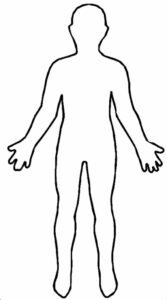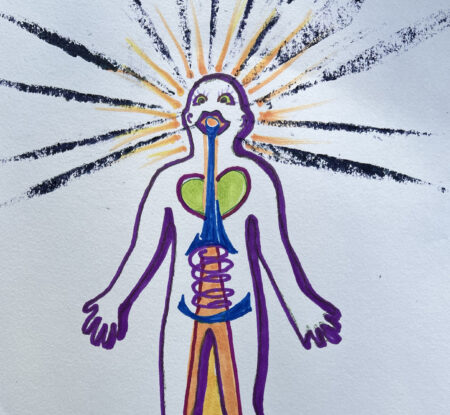Rebecca was ambivalent about a simple decision she had to make—to sign up for a training or not. It was expensive but compelling. Was it the right time? Worth the cost? Really necessary? When she asked KC, her husband, for advice, he said, “Just trust your gut.”
Just Tell Me What To Do!
Not helpful! She really just wanted someone or something to give her the answer: yes or no! Rebecca also thought with irony of the many times she’d heard the same thing from her clients—essentially “Just tell me what to do!”
Connecting To Our Gut
Perhaps by no coincidence, an article on this very topic had appeared that very morning in Rebecca’s inbox. Written by Sara Briggs, author of “How to Change Your Body,” it talks about challenges many of us face connecting to our bodies–either because we don’t recognize or acknowledge the importance of physical cues or because we’re inundated with so many sensations that we become overwhelmed and can’t interpret their significance.
Why Trusting Your Gut Matters
Apart from helping us to make decisions, apparently “trusting our gut” is important to our mental health. It is giving us information that is not only important for our own personal wellbeing, but for our relationships, a way for us to interpret what is happening in and around us and to help guide how we proceed from there.
How Do We Interpret Our Bodies’ Messages?
The question then is how do we understand the messages our bodies are giving us? Briggs lists a series of actions we can take to develop this skill, otherwise known as interception–the capacity to sense our body from within.
Here are some of those suggestions:
- Body scans to tune into all parts of our body (click here for access to UCLA’s library of body scans and breathing meditations)
- Taking an assessment of our Body Awareness/Interoception (click here to access that assessment)
- Developing a vocabulary to describe how we’re feeling
- Noticing what we think and believe about what we’re feeling
- If we are interpreting body sensations negatively, reappraising (finding more empowering narratives) of the meaning we attribute to those feelings
- Practicing Social Interoception, getting to know how our body responds to others and social situations
- Practicing Attentional Shifting—going between our own intrapersonal experience and what we experience in interacting with others
- We add a handout on practicing Mindful Observing (click here for access)

Art Exercise to Tap Into the Body
Not surprisingly, we’ve got an art therapy twist to this. We suggest taking outline of a figure and drawing what your body is experiencing. So after doing a body scan, Rebecca set about this task. The featured image here was the result.
The Art Has the Answer
Rebecca discussed the image with KC to get some help with understanding what it was communicating (even artists /art therapists can have blinders on when it comes to their own art). She and KC observed that there was a strong upward movement that seemed to be conveyed by the blue upward spiral in the belly and the warm flow moving up from the orange ground.
Other Visual Messages
They also noticed that the figure seemed to be suspended, as if it were levitating. On the one hand there a sense of the figure being overtaken by the upward surge, perhaps even helplessly overcome, but because of the marks around the head going outward, there was a sense that the figure was radiating that energy outward. As if it were being channeled and then intensely emanating.
“Yes” or “No” Not Spelled Out
Although Rebecca did not get a direct “yes” or “no”, the image seemed to communicate a sense of allowing, of responding to a larger calling and serving as a channel for that message. Checking in with her body, that “felt” right to her so she decided to do the training. She also felt a sense of release in her body when she did so, a relaxation in her mid-section that seemed to reflect a congruency between her decision and her body’s reaction to it.
Metaphors To Reflect On
The beauty of art is that it provides us with metaphors that we can mine for meaning. As Rebecca continued to reflect on her image, she noticed interesting things like the fact that the heart appeared to be “split” by the lines going up through the chest. Also that the color of the heart and the eyes appeared to be the same–a light sage green. And that the eyes looked a little bit surprised and even perplexed. She hadn’t yet come to a conclusion about what those metaphors meant, but it gave her lots of material to reflect on and journal about.
The Message In This Blog
The bottom line is that our bodies are communicating helpful information but some of us need tools to connect to those messages. Sara Briggs’ suggestions, which at their core relate to developing mindful awareness of what’s happening in our body, are helpful. And we suggest taking it a step further with art, it will enrich the picture further.
Warmly (from our hearts), Rebecca and Gioia
 Art Directive
Art Directive
Print out the outline of the figure (or draw your own outline). Spend a couple of minutes with your eyes closed doing a body scan from your feet through your legs, torso, arms, neck and head. Notice sensations (or lack thereof) and capture what those feel like with color, line and shape.
When you’re done, take a moment to look at the visual elements that your image presents. You might do this with another person because the artist rarely sees the image objectively (we’re usually focused on what we intended to make and less on what we actually did make!). You might then journal about what the images and the metaphors that it holds tells you about yourself and your body at this moment.
Feel free to reach out and email us if you want some help understanding the messages that your image is communicating.
